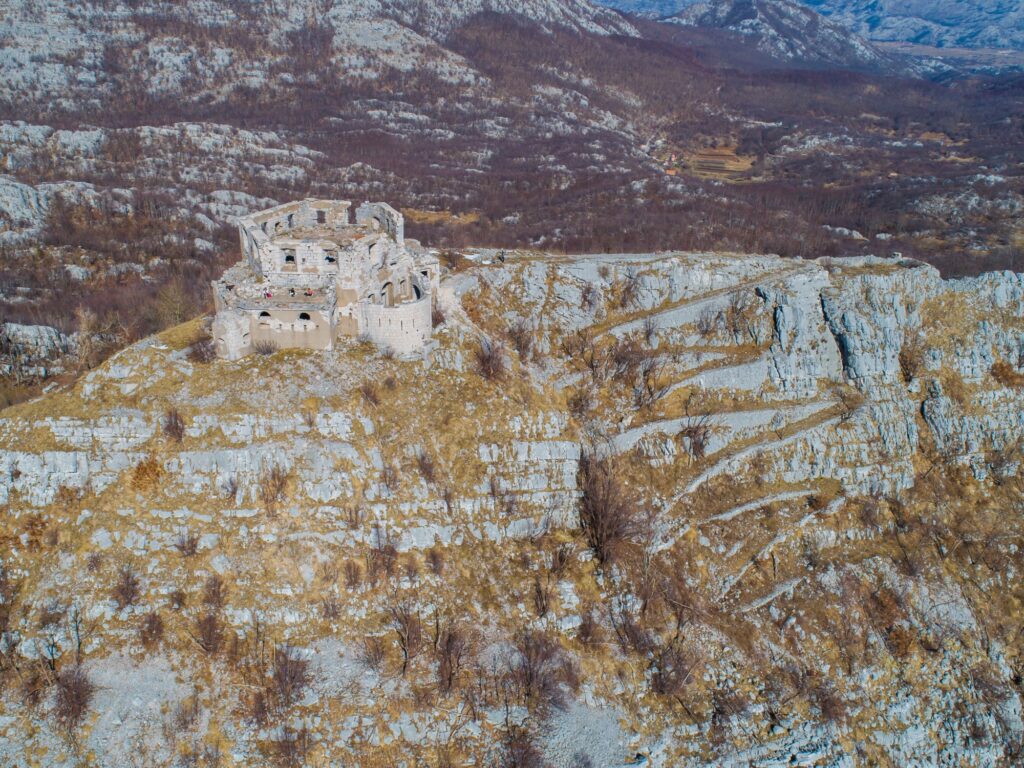Guides / Fortifications in Bay of Kotor
Boka Kotorska – Southernmost Austro-
Hungarian Fort
The fortress functioned as a place prepared for circular defense in order to protect the population, close a route, or as a base and support for offensive actions. It usually had a permanent crew and weapons. The role, significance, shapes and objects of the fortress changed depending on the concept of warfare, the range and the destructive power of weapons. In Montenegro, the most famous is the complex of Austrian fortresses, built in the Bay of Kotor and Paštrovići mainly during the 19th century. Today it is a kind of attraction for all lovers of nature walks
___________________________________________________________________________________________________________
Adapted from Werk – Austro-Hungarian Fortifications in the Bay of Kotor by Radojica Rašo Pavićević
The steep shore of the Bay of Kotor is formed by the slopes of the surrounding mountains, in the form of four smaller basins, i.e. bays: Herceg Novi, Tivat, Risan and Kotor. Due to its position near the Strait of Otranto, and the relief, Boka has always been of exceptional strategic importance, and was considered one of the best ports.
Although the first traces of civilisation in Boka date back to the VIII century BC, the first fortifications were Illyrian. After the Illyrians, and with the division of the Roman Empire into Eastern and Western halves, Boka belonged to the West. The armies would come and go, the great powers left their traces of civilisation and achievements.
Numerous wars and changes of government have largely influenced its cultural character. At the beginning of the 6th century, the Goths were here. In the 7th century it was inhabited by Slavs. Then begins a period of frequent shifts of Byzantine rulers and shorter authorities of South Slavic families; and so on until the end of the twelfth century. In the meantime, in the ninth century, the Arabs and Saracens stayed for a short time. In the 12th century, Boka was occupied by the Serbian dynasty Nemanjić, which remained there until 1371, when it came under the protectorate of the Hungarian King Ludwig I, and from 1385 King Tvrtko. After Tvrtko’s death, Kotor was independent from 1391 to 1420, and then, under the threat of Turkish conquest, was requested a Venetian protectorate.

Fort St. Andrew
In 1483, the Turks occupied the coast from Risan to Herceg Novi. The Venetians kept only Kotor and the southern part of Boka. At the end of the 17th century, the Venetians drove the Turks out of Herceg Novi, and in 1725 they annexed the entire Boka.

Fort Škaljari
Concluded the Treaty of Campo Formio 1797, Boka belonged to Austria. Nevertheless, there was a constant fear of French occupation. The population was divided into Orthodox who were looking forward to Montenegrin rule, and Catholics who expected Austrians.
Although this agreement was supposed to bring peace, the intertwining of interests between Austria, Britain, France and Russia in the coming years will lead to frequent conflicts. Particularly dramatic was the period from 1805 to 1812, that is, the period of French rule, which was marked by great scarcity. French maritime traffic was then disabled in the Adriatic. Therefore, French base in Kotor was far from the center and means of supply for the army. This resulted in great pressure on the local population to help the army with money, food, ships, people, which affected the overall standard of living of the citizens, and consequently a great increase in dissatisfaction. After the end of French rule, the Austrians came again.
Both conquerors were very aware of the strategic position of Boka and the necessity of securing it. The French immediately began to fortify Boka as a whole, and the Austrians continued. The system of coastal fortifications developed depending on the importance of individual parts of the coast, assessments of the best places to base the fleet,
as well as the military-political situation in a given period of time. Austria inherited a large number of fortifications from the French army. Until the Mid-19th century period, it used the existing fortifications with minor adjustments. However, from that time, due to a sudden improvement of tactical and technical characteristics of weapons, the existing fortifications in the form of city walls, and port castles could no longer provide sufficient security and meet new requirements in organising defense of the coast and the port. That is why they adapted the existing system to the new conditions.
The naval defense of the Bay of Kotor became increasingly important, both because of Austria-Hungary’s strategic plans for expansion to the east, the proximity of Otranto and the Montenegrin border. That is why the Bay of Kotor, starting from 1882, began its quick modernisation.
The Boka Kotorska Fortress was built with the aim of protecting its core, i.e. the base and the war port, and at the same time closing the routes from the sea to the interior. Due to the protection of the core, the fortress grew during the 114 years that the Austro-Hungarians used it. So the Boka fortress was in fact the entire territory of the Bay of Kotor, the Krivošije hinterland and the Budva-Paštrovačka part all the way to the Željeznica river near Bar. Austria was aware of the position of the Boka and the proximity of the Straits of Otranto as the entrance to the Adriatic. If the danger came from outside the Adriatic forces then door control was important to successfully counter those forces.
Unlike merchant ships that stay in ports for a short time, warships have to spend a lot of time in their base, not only for resting crews, repairing damage, revitalizing combat capabilities, but also for training, combat operations and preparation.

Fort Kom
Therefore, the base must have constant sources of supply. Despite the decision to build a military base in Boka, Austria was aware that its supply would be the biggest obstacle, and that land connections were directed exclusively to Dubrovnik and Sarajevo. Thus, food, water and equipment had to be provided for a relatively large number of forces.
Due to a large number of horses, the veterinary service also had to be developed. In addition to all that, it was necessary to develop a road network in the roadless hinterland of Boka, as well as in Paštrovići, which would enable life and work in the conquered area. The whole system had to be paid, from building fortifications, salaries for officers and soldiers, labor, land acquisition, investing in innovations and new equipment, to repairing equipment, building roads, water, playgrounds, shooting ranges, cemeteries, airports, railways. A special problem was the poor passability, so many roads had to be built. The lack of drinking water in this area was a big problem, so it took a lot of effort to solve it as well.












